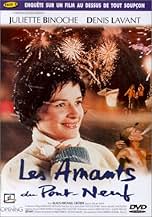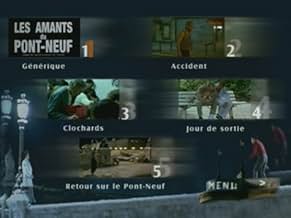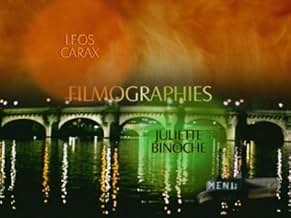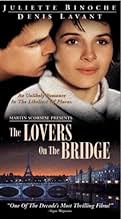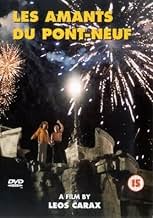अपनी भाषा में प्लॉट जोड़ेंAlex, who's homeless and addicted to alcohol, and Michèle, who's losing her sight, form a relationship while sleeping rough on Paris's Pont-Neuf bridge.Alex, who's homeless and addicted to alcohol, and Michèle, who's losing her sight, form a relationship while sleeping rough on Paris's Pont-Neuf bridge.Alex, who's homeless and addicted to alcohol, and Michèle, who's losing her sight, form a relationship while sleeping rough on Paris's Pont-Neuf bridge.
- 1 BAFTA अवार्ड के लिए नामांकित
- 4 जीत और कुल 8 नामांकन
Chrichan Larsson
- Julien
- (as Chrichan Larson)
फ़ीचर्ड समीक्षाएं
Oddly enough, "Les Amants du Pont-Neuf" reminded me of Francis Ford Coppola's own romantic extravaganza, "One From the Heart." Think about it: both were directed by cinematic wunderkinds; both went way over budget and had troubled productions; and both were, at their hearts, rather simple love stories that their directors inflated, rather perversely, into massive technical undertakings.
On that level, at least, "Les Amants..." works. The movie is filled with striking images -- the fireworks display as seen from Pont-Neuf, the flaming posters lining the walls of the Metro, and so on. It is not at all inaccurate to call this one of the most stunningly photographed films of all time.
But whereas the movie succeeds as a grand visual spectacle, it disappoints just about everywhere else. The relationship between Alex (Denis Levant) and Michele (Juliette Binoche, who manages to be as radiant as ever in spite of her role as a fairly grungy homeless painter) occasionally results in some moments of pure emotional power, which are promptly deflated with one of Alex's bizarre, unexplained transformations into a possessive, selfish, nearly sociopathic jerk. (His dreadfully unconvincing hyena-laugh doesn't help much.) Since the romance between these two characters is the crux of the film, this inconsistency mortally wounds the film. Maybe Carax was trying to convey a sense of the "amour fou" French romances are famous for; if so, he failed.
Even worse, though, are the myriad subplots that Carax introduces but doesn't do anything with. The old man (Klaus-Michael Gruber) with whom Alex hangs around with serves no purpose other than to give Michele the key to an art museum, yet he has the film's only significant supporting role. And it becomes clear later in the film that Michele (who is rapidly losing her sight) is, in fact, on the run from her past, but we learn next to nothing of it -- who, exactly, is "Marion"? Why does Michele (apparently) shoot her ex-boyfriend, Julien? These aren't just anal-retentive questions -- these are major plot points that would have helped tremendously in developing Michele. But Carax doesn't care; he was either in too much of a hurry to get the script done (not at all unlikely -- see the "Trivia" section), or didn't regard the story as anything more than a clothesline to hang his visuals on.
There are two other major irritations. First is the way the plot falls back on the "miracle-working ophthalmologist." You know that device: that's the one were the hero/heroine is/is going blind but can have his/her sight saved by visiting some lone eye surgeon who has developed a miraculous cure for their affliction. Not only does this trivialize Michele's torment, but it also robs the film of what could have been an even more poignant ending -- surely I'm not the only one who thinks the portrait-painting scene would've been more touching if Michele had done it blindly.
That brings me to the second sore spot: the ending. Michele ominously tells Alex she has to leave; Alex flies into a rage and pushes her into the Seine, following her in. When they rise to the surface, though, Michele is laughing as though Alex's little tantrum had never happened, as though she doesn't care that he would rather see her drown than risk losing her. (We're never told, by the way, why Michele had to leave.) They then board a garbage barge together, and the film suddenly turns into an homage to Vigo's "L'Atlante" that is so blatant that the only way it could've been more obvious was if Vigo had received co-directing credit. Since nothing else in the film suggests "L'Atlante," this unexpected reference comes across as just more evidence of sloppy writing, that Carax couldn't be bothered to think of a decent ending and just threw together the unsatisfying (but beautifully shot -- go figure) climax we're stuck with.
Don't get me wrong -- this is NOT a bad film. But it IS a tremendous disappointment, even for me, who has never exactly been a fan of Carax's work. Foreign film buffs should still see it -- maybe you'll have better luck focusing on the sights and sounds and blocking out the meandering screenplay.
On that level, at least, "Les Amants..." works. The movie is filled with striking images -- the fireworks display as seen from Pont-Neuf, the flaming posters lining the walls of the Metro, and so on. It is not at all inaccurate to call this one of the most stunningly photographed films of all time.
But whereas the movie succeeds as a grand visual spectacle, it disappoints just about everywhere else. The relationship between Alex (Denis Levant) and Michele (Juliette Binoche, who manages to be as radiant as ever in spite of her role as a fairly grungy homeless painter) occasionally results in some moments of pure emotional power, which are promptly deflated with one of Alex's bizarre, unexplained transformations into a possessive, selfish, nearly sociopathic jerk. (His dreadfully unconvincing hyena-laugh doesn't help much.) Since the romance between these two characters is the crux of the film, this inconsistency mortally wounds the film. Maybe Carax was trying to convey a sense of the "amour fou" French romances are famous for; if so, he failed.
Even worse, though, are the myriad subplots that Carax introduces but doesn't do anything with. The old man (Klaus-Michael Gruber) with whom Alex hangs around with serves no purpose other than to give Michele the key to an art museum, yet he has the film's only significant supporting role. And it becomes clear later in the film that Michele (who is rapidly losing her sight) is, in fact, on the run from her past, but we learn next to nothing of it -- who, exactly, is "Marion"? Why does Michele (apparently) shoot her ex-boyfriend, Julien? These aren't just anal-retentive questions -- these are major plot points that would have helped tremendously in developing Michele. But Carax doesn't care; he was either in too much of a hurry to get the script done (not at all unlikely -- see the "Trivia" section), or didn't regard the story as anything more than a clothesline to hang his visuals on.
There are two other major irritations. First is the way the plot falls back on the "miracle-working ophthalmologist." You know that device: that's the one were the hero/heroine is/is going blind but can have his/her sight saved by visiting some lone eye surgeon who has developed a miraculous cure for their affliction. Not only does this trivialize Michele's torment, but it also robs the film of what could have been an even more poignant ending -- surely I'm not the only one who thinks the portrait-painting scene would've been more touching if Michele had done it blindly.
That brings me to the second sore spot: the ending. Michele ominously tells Alex she has to leave; Alex flies into a rage and pushes her into the Seine, following her in. When they rise to the surface, though, Michele is laughing as though Alex's little tantrum had never happened, as though she doesn't care that he would rather see her drown than risk losing her. (We're never told, by the way, why Michele had to leave.) They then board a garbage barge together, and the film suddenly turns into an homage to Vigo's "L'Atlante" that is so blatant that the only way it could've been more obvious was if Vigo had received co-directing credit. Since nothing else in the film suggests "L'Atlante," this unexpected reference comes across as just more evidence of sloppy writing, that Carax couldn't be bothered to think of a decent ending and just threw together the unsatisfying (but beautifully shot -- go figure) climax we're stuck with.
Don't get me wrong -- this is NOT a bad film. But it IS a tremendous disappointment, even for me, who has never exactly been a fan of Carax's work. Foreign film buffs should still see it -- maybe you'll have better luck focusing on the sights and sounds and blocking out the meandering screenplay.
This is one of the great romances precisely because it goes against the grain of all the great screen romances. Because of its ability to strike new terrain -- to go where no romance has gone before, to take chances, in essence -- it achieves a level of passionate intensity that most romantic films could only dream of mustering.
The camera work -- by Jean-Yves Escoffier, one of the great cinematographers working today (who shot Leos Carax's early films -- "Bad Blood" and "Boy Meets Girl" -- as well as Larry Clark's "Kids," and the directorial debut of Harmony Korine, "Gummo") -- is absolutely breathtaking. I cannot overemphasize this. It is, perhaps, one of the most beautiful color films ever made. The style of the film suits the subject matter perfectly. It proves that the great films have a form that not only compliments the subject matter, but becomes it. The content is the form, and vise versa. The film is shot "Cinema-Verite" style, with rough, hand-held, choppy camerawork, and a gritty, realistic aesthetic quality. There are moments of fancy and surrealism that would seem to utterly contradict this style. On the contrary, these moments are rendered believable, avoid presenting problems of logic, because of the film's harsh, balancing tone. The "wild" style of the film captures perfectly the passionate, stormy affair of the lovers -- the truest love, and certainly the most passionate, the film says, is that closest to nature, to the base element of humanity.
Another layer of enjoyment comes from the film's similarity to Jean Vigo's "L'Atlante." In fact, the final sequence in the film has the two lovers plummeting from the bridge into the cold water. They are picked up by a sand barge, on its final trip to the ocean. The husband and wife, who we learn have spent their life shipping sand, agree to take them along. It is almost as if the couple in "L'Atlante" have reappeared to prove that passionate, tumultuous love affairs can end happily, despite their problems. One of the last shots of the film shows the two lovers walking across the barge, over the hills of sand, to the bow -- a direct quotation of "L'Atlante."
The last shot (for enemies of James Cameron's "Titanic" -- an absolutely shallow romance; as cold and heartless as the iceberg that dooms the ship) shows the two lovers hovering over the bow of the ship, magically, as if suspended by love. It is obvious James Cameron plagiarized this moment ("Les Amants..." came out in 1991). This fact should be trumpeted far and wide. "Titanic" is a bloated whale of a movie. "Les Amants du Pont Neuf" is simply the greatest romance to have erupted on the screens in the last decade.
The camera work -- by Jean-Yves Escoffier, one of the great cinematographers working today (who shot Leos Carax's early films -- "Bad Blood" and "Boy Meets Girl" -- as well as Larry Clark's "Kids," and the directorial debut of Harmony Korine, "Gummo") -- is absolutely breathtaking. I cannot overemphasize this. It is, perhaps, one of the most beautiful color films ever made. The style of the film suits the subject matter perfectly. It proves that the great films have a form that not only compliments the subject matter, but becomes it. The content is the form, and vise versa. The film is shot "Cinema-Verite" style, with rough, hand-held, choppy camerawork, and a gritty, realistic aesthetic quality. There are moments of fancy and surrealism that would seem to utterly contradict this style. On the contrary, these moments are rendered believable, avoid presenting problems of logic, because of the film's harsh, balancing tone. The "wild" style of the film captures perfectly the passionate, stormy affair of the lovers -- the truest love, and certainly the most passionate, the film says, is that closest to nature, to the base element of humanity.
Another layer of enjoyment comes from the film's similarity to Jean Vigo's "L'Atlante." In fact, the final sequence in the film has the two lovers plummeting from the bridge into the cold water. They are picked up by a sand barge, on its final trip to the ocean. The husband and wife, who we learn have spent their life shipping sand, agree to take them along. It is almost as if the couple in "L'Atlante" have reappeared to prove that passionate, tumultuous love affairs can end happily, despite their problems. One of the last shots of the film shows the two lovers walking across the barge, over the hills of sand, to the bow -- a direct quotation of "L'Atlante."
The last shot (for enemies of James Cameron's "Titanic" -- an absolutely shallow romance; as cold and heartless as the iceberg that dooms the ship) shows the two lovers hovering over the bow of the ship, magically, as if suspended by love. It is obvious James Cameron plagiarized this moment ("Les Amants..." came out in 1991). This fact should be trumpeted far and wide. "Titanic" is a bloated whale of a movie. "Les Amants du Pont Neuf" is simply the greatest romance to have erupted on the screens in the last decade.
...but what style! The most expensive French film ever made when it came out, this film features some spectacular set-pieces, particularly the French bi-centennial celebrations that provide a backdrop. It has its weaknesses, but when I saw this in the cinema I was blown away. Denis Lavant puts in a particularly strong performance as Alex, the depressive and tender down-and-out obsessed with Binoche's Michele. Watch it, even if you find nothing else in it, the visuals are astonishing.
Of the four feature films from French writer-director Leos Carax, 1991 "Les Amants du Pont-Neuf" is the most hopeful and happy (mind you it's not the generic definition of 'happy' per se), still a story of love, an extraordinary loving relationship maturing through time and fateful instances as the film progresses. You might even agree afterall, that the whole journey of experience is rather satisfying. Director Leos Carax once again demonstrated a feast of his talented visual eye: things, faces, scenes, close-ups, aerial or simple wide shots, are composed, captured within the frames, graphically presented. He optimized the use of colors and movements: a fete of lights and fireworks celebrations, dazzling fire-eating shows, caressing shots of waves in motion of zigzagging speed boat and water-skiing.
Carax sure didn't water down any sentiments - he used bold strokes with no apology: his intro showed us the 'unpleasant' side of Paris, the dream city of Europe has homeless and sights of street people, too. Binoche, as always, dependably delivered an intense portrayal of this artist, Michele, on the verge of going blind (note the ending credits roll indicating the paintings were done by Juliette Binoche herself), and as the story unfolds, has a past mesmerizingly mysterious to Lavant's Alex character.
Again captured on film is Denis Lavant's legs a-moving within a frame running, dancing. Reminiscent of Truffaut and Jean-Pierre Leaud's Antoine filmic partnership - Lavant is Alex in three of Carax' endeavors: "Boy Meets Girl" 1984; "Bad Blood" 1986; and here in "The Lovers on the Bridge." (To see Denis Lavant away from his 'boyish' roles, try French director Claire Denis' 1999 "Beau Travail" - another intense delivery, and we actually get to see more of Lavant's solo legwork a-dancing.)
Yes, it's quite an ambitious film. Carax packed a lot of layers of emotions, spins and details, along with stunning visual angles and photographic magic in this one story. He is truly a passionate filmmaker and dramatic writer. Binoche and Lavant performed terrifically well together, and the third character, Klaus Michael Gruber as Hans the homeless senior also with a mysterious past, added accents with his performance. The sequence towards the end, first you get the telling of a joke with hearty laughter, then the fateful phrase of "ce soir c'est le soir", to the underwater sequence and what follows - Carax would not let up with any moment for you, the audience, to breathe after laughs and gasps. Choreographed magic? Yes. Go see it for yourself. Hang in there with the pair and you will not be disappointed. Have an open mind and you'll enjoy it.
Carax sure didn't water down any sentiments - he used bold strokes with no apology: his intro showed us the 'unpleasant' side of Paris, the dream city of Europe has homeless and sights of street people, too. Binoche, as always, dependably delivered an intense portrayal of this artist, Michele, on the verge of going blind (note the ending credits roll indicating the paintings were done by Juliette Binoche herself), and as the story unfolds, has a past mesmerizingly mysterious to Lavant's Alex character.
Again captured on film is Denis Lavant's legs a-moving within a frame running, dancing. Reminiscent of Truffaut and Jean-Pierre Leaud's Antoine filmic partnership - Lavant is Alex in three of Carax' endeavors: "Boy Meets Girl" 1984; "Bad Blood" 1986; and here in "The Lovers on the Bridge." (To see Denis Lavant away from his 'boyish' roles, try French director Claire Denis' 1999 "Beau Travail" - another intense delivery, and we actually get to see more of Lavant's solo legwork a-dancing.)
Yes, it's quite an ambitious film. Carax packed a lot of layers of emotions, spins and details, along with stunning visual angles and photographic magic in this one story. He is truly a passionate filmmaker and dramatic writer. Binoche and Lavant performed terrifically well together, and the third character, Klaus Michael Gruber as Hans the homeless senior also with a mysterious past, added accents with his performance. The sequence towards the end, first you get the telling of a joke with hearty laughter, then the fateful phrase of "ce soir c'est le soir", to the underwater sequence and what follows - Carax would not let up with any moment for you, the audience, to breathe after laughs and gasps. Choreographed magic? Yes. Go see it for yourself. Hang in there with the pair and you will not be disappointed. Have an open mind and you'll enjoy it.
I've just watched this film and, out of curiosity, the comments of several contributors to this bulletin board. Simply can't fathom the glowing enthusiasm of most of these - though I suppose they are self-selected from those who have actually been able to sit through it.To me it seemed phony, pretentious, and in the end unbelievably boring - both words here seem applicable alone as well as in tandem. I'm rather fond of Binoche, and this may have something to do with my impression that she found the role one that couldn't be played convincingly - that she as a result could only stumble through it sans conviction. Why did I then watch it through? In the hope of some saving grace - which I certainly failed to find in that silly resolution.
क्या आपको पता है
- ट्रिवियाLeos Carax was originally given permission to use the real Pont-Neuf bridge in Paris and have it closed for filming but delays in filming meant the permission expired and he had to reconstruct the whole thing on a lake near Montpellier, France. The construction of a new version of the Pont-Neuf - and its surrounding buildings in Paris - helped make the film one of the most expensive French films ever made.
- गूफ़Just before Alex jumps out of the speedboat, a crew person is visible hunched down in ninja clothing to pilot the boat.
- भाव
Michèle Stalens: The people in our dreams, we should call them when we wake up. It would make life simpler. "Hello, I dreamed of you. Love woke me".
- क्रेज़ी क्रेडिटAfter the last end title, during a fraction of a second, there is a handwritten inscription "à Luje - Amour - A." (To Luje - Love - A.) A. stands for Alexandre (Leos Carax' real first name) and Luje for Juliette (Binoche).
- कनेक्शनFeatured in Enquête sur un film au-dessus de tout soupçon (1991)
- साउंडट्रैकTime Will Crawl
Written and performed by David Bowie
टॉप पसंद
रेटिंग देने के लिए साइन-इन करें और वैयक्तिकृत सुझावों के लिए वॉचलिस्ट करें
- How long is The Lovers on the Bridge?Alexa द्वारा संचालित
विवरण
- रिलीज़ की तारीख़
- कंट्री ऑफ़ ओरिजिन
- आधिकारिक साइट
- भाषा
- इस रूप में भी जाना जाता है
- The Lovers on the Bridge
- फ़िल्माने की जगहें
- Boulevard de Sebastopol, पेरिस, फ़्रांस(Car hits Lavant)
- उत्पादन कंपनियां
- IMDbPro पर और कंपनी क्रेडिट देखें
बॉक्स ऑफ़िस
- बजट
- $2,80,00,000(अनुमानित)
- US और कनाडा में सकल
- $29,679
- US और कनाडा में पहले सप्ताह में कुल कमाई
- $21,482
- 4 जुल॰ 1999
- दुनिया भर में सकल
- $32,225
- चलने की अवधि2 घंटे 5 मिनट
- रंग
- पक्ष अनुपात
- 1.66 : 1
इस पेज में योगदान दें
किसी बदलाव का सुझाव दें या अनुपलब्ध कॉन्टेंट जोड़ें


![Bande-annonce [OV] देखें](https://m.media-amazon.com/images/M/MV5BY2Q3NmQ3MzctYTU4OC00ZjA5LTkzNDMtZWEzMjM2MzZmNGM0XkEyXkFqcGdeQXRyYW5zY29kZS13b3JrZmxvdw@@._V1_QL75_UX500_CR0)

